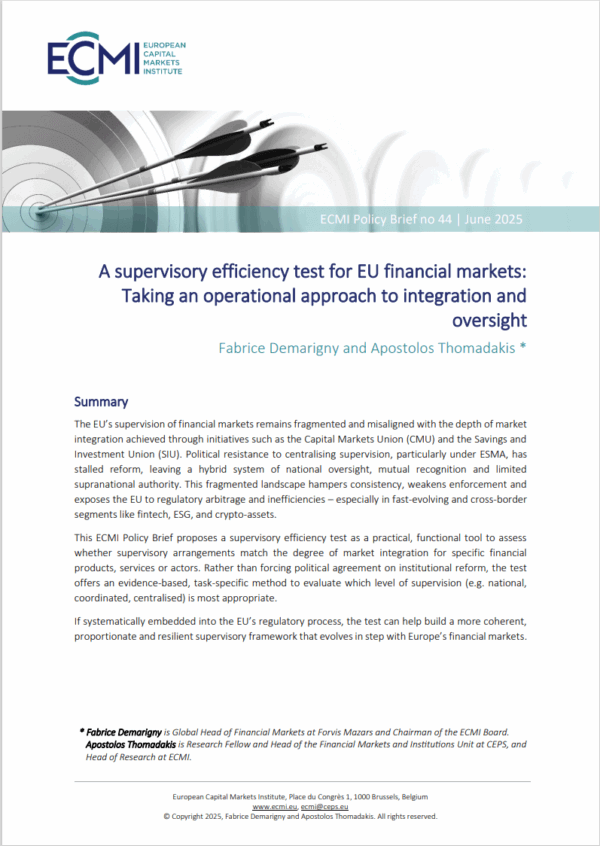Authors: Willem Pieter De Groen and Daniel Gros
Series: CEPS Commentary
While waiting for the results of the stress to be announced on Friday, July 29th, it is worth taking a closer look at the case of Banca Monte dei Paschi di Siena (MPS), which constitutes the most visible example of the problems facing the Italian banking sector.
The starting point must be that MPS has been living on the edge for many years. The Italian bank has failed, or has been close to failing, in all the previous EU-wide stress tests since 2010. The overall amount of value destruction in this single case can be gauged by the fact that MPS has raised about €16 billion in capital over the last 10 years, but its market value is now only a few hundred million. Moreover, the (regulatory) capital cushion has remained relatively thin.
The key indicator these days is the true value of a bank’s non-performing loans (NPLs). About one-third of MPS’ total loan book is not performing, compared to about one-fifth for the average in the Italian banking system. There have thus clearly been problems in risk control at MPS.
Whether or not MPS needs to be recapitalised depends almost entirely on how much value one assigns to its €50 billion or so (gross) of non-performing loans. In a worst-case scenario (value of NPLs on average only 20%), the bank would need to be resolved and some bail-in of debt would be unavoidable. The best-case scenario would be that the recent changes to insolvency laws and procedures would allow recovery rates on its NPLs to go up to their present book value (around 40%). In this case, there would be no need for any bail-in and little need for additional capital. The Italian government (and the Italian banking association) are of course arguing that the latter is the most likely scenario. European regulators and supervisors, however, have to adopt a more cautious stance.
No one at this point can determine with any certainty the true value of NPLs (and not only those of MPS). The market for them is rather thin and every single non-performing loan is a special case. It is thus impossible to make generalisations. Formally, most loans are underpinned by collateral which comes close to covering today’s book value. For most SME and other corporate loans, however, the collateral consists of machinery and industrial buildings, which are worthless when the enterprise that is using those items has gone out of business.
Moreover, experience suggests that the book value of the NPLs today is not a good guide to their longer-term value. Over the last decade the Italian banking system has made a profit in most year at a similarly low rate as the European average. From time to time, however, Italian banks show huge losses. This occurs in general when they are forced by the European authorities to write down the book value of some assets. Each time, the banks naturally protest that this is exaggerated and that the true value is much higher. If this had been true, however, i.e. if the enforced write-down had been excessive, the banks would have made large profits in the following years as the true value emerged. But this has never happened and it is difficult to see why this time should be different.
Figure 1. Return on equity for EU, Italy and MPS, 2007-15 (%)

Note: The figure shows the return on equity for the European Union (EU), Italy (IT), and Banca Monte dei Paschi di Siena (MPS).
Source: Authors’ elaboration based on ECB consolidated banking data and financial statements from Banca Monte dei Paschi.
The argument that forcing MPS to sell its NPLs quickly would not allow the bank to recover its true value (‘fire sale’) is not convincing, given that the problem has been known for years. However, it now seems that the problem will be pushed into the future by a bridge loan from a consortium of private investors (‘friends of MPS’), allowing MPS to put the NPLs into a separate vehicle and dispose of them more gradually at a later date. A ‘government-sponsored’, but formally private-sector, rescue operation represents probably the path of least resistance at this point since it would avoid the need for a bail-in of subordinate debt holders.
We also note that bailing-in the holders of subordinated debt would create much less social hardship than one might expect from the anecdotal evidence from the failure of the four small Italian banks late last year (Banca Marche, Banca Etruria, Carife and Carichieti). Data from the Banca d’Italia indicate that over 85% of all the subordinated debt is held by 10% of households in the highest wealth bracket.
Willem Pieter de Groen is Research Fellow at CEPS and Daniel Gros is Director of CEPS. This commentary summarises the results of a forensic examination carried out of the MPS over the last few years. For more information, see companion piece published by Willem Pieter De Groen, entitled “A closer look at Banca Monte dei Paschi: Living on the edge”, CEPS Policy Brief No. 345, 28 July 2016. CEPS Commentaries offer concise, policy-oriented insights into topical issues in European affairs. The views expressed are attributable only to the authors in a personal capacity and not to any institution with which they are associated.
© CEPS 2016














